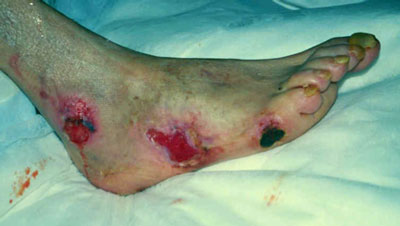Arterial ulcers have certain characteristics clinicians can easily identify. Inadequate blood supply is a main cause of non-healing wounds. Arterial wounds usually appear on the distal part of the leg over the lateral malleolus, mid-tibial, between or tips of toes, or over phalangeal head (Wound, 2013).
Assessment and Characteristics
These wounds typically have a “punched out” appearance and are pale, dry, or necrotic. Pulses are reduced or absent and the skin may feel cool or cold to touch. Risks factors for peripheral arterial disease include hypertension, diabetes, trauma, advanced age, smoking, and hyperlipidemia. Pain is often associated with these wounds; it is referred to as intermittent claudication or “rest pain.” Pain occurs during activity such as walking and subsides during periods of rest.
When the leg is elevated, the patient can experience an increase in pain due to the decrease in blood flow to the limb. Most of the time, the patient feels a relief in pain when the legs are in a chair position and gravity pulls blood to the lower extremities. Light exercise, while it can be painful, is also a source of treatment for this pain by conditioning the muscles to use oxygen more efficiently.
Arterial Insufficiency Wound

Source: Copyright 2003, AAWC.
Treatment
Treatment options for these wounds requires re-vascular intervention and studies to identify blood flow problems in the veins. Wound center or vascular referrals are necessary in combination with topical wound treatment to prevent infection until increased circulation can be achieved. Angioplasty or operative interventions are designed to increase the blood flow required for wound healing.
These wounds will not heal without appropriate interventions, and this can be difficult for patients and caregivers to comprehend. Debridement is not an option if there is insufficient blood flow. Not only will these arterial wounds not heal effectively but the risk of infection will also increase with an increase in wound size.
If revascularization is not an option, amputation will be the next possible step. Patients and caregivers may postpone having testing done for fear of the results. Clinicians need to encourage early interventions and testing to prevent further pain, complications, and the risk of amputation. Wound care with arterial wounds begins with controlling diabetes, encouraging ambulation, and teaching smoking cessation and topical wound care to prevent infection and additional pain.
Make sure patients protect their limbs from future trauma and begin to focus on the appropriate plan of care. Once adequate blood flow is established, if that is still possible, wound treatment should include a moist healing environment and infection control. It is necessary for patient and caregivers to realize that without sufficient blood flow to the extremities, wound healing will not occur. There are many times when caregivers and patients do not comprehend the reason behind the plan of care simply because they do not understand wound healing starts on the inside with adequate blood supply.
Topical treatment should be done to encourage wound healing and prevent infection until revascularization can be performed. Encourage the patient to seek vascular intervention as soon as possible instead of waiting for future appointments. Patient and caregivers may be afraid to hear study results but teach them that earlier intervention means quicker healing and reduces the risks of complications that could lead to amputation.
Dry stable black eschar in a non-infected ischemic wound (commonly called “nature’s band-aid”) should be maintained and not debrided until vascular intervention can increase perfusion status. Treatment goals should be to continue infection treatment, prevent additional trauma and injury, promote wound healing, reduce pain, and preserve the limb (Wound, 2013).
